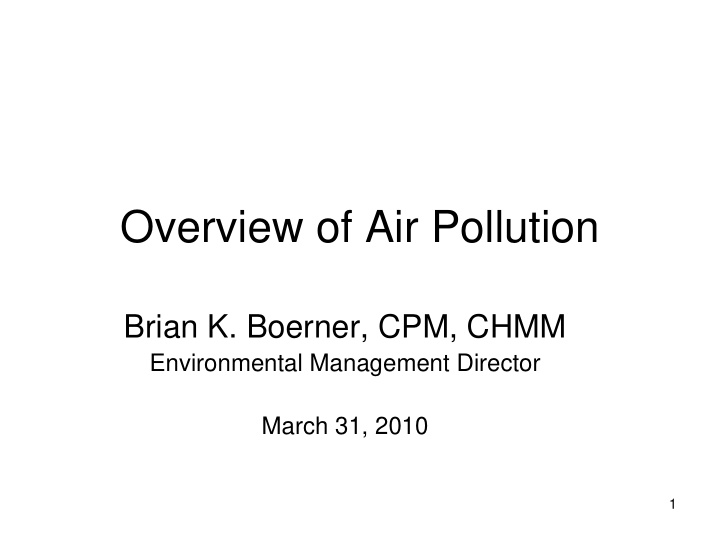



Overview of Air Pollution Brian K. Boerner, CPM, CHMM Environmental Management Director March 31, 2010 1
What is Air Pollution? • The presence of substances that interfere with human health or welfare, or produce harmful environmental effects – Chemicals – Particulate matter – Biological materials • The Federal Clean Air Act Amendments (1990) – State Delegation 2
Federal Clean Air Act NAAQS Air Toxics Benzene PM2.5 Dust ozone lead Carbon Disulfide CO Nuisance Odor NO 2 sO 2 3
National Ambient Air Quality Standards • Set standards for pollutants considered harmful to public health and the environment. – Primary standards protect public health, including the health of "sensitive" populations such as asthmatics, children, and the elderly. – Secondary standards protect public welfare, including protection against decreased visibility, damage to animals, crops, vegetation, and buildings. 4
National Ambient Air Quality Standards Standards set for six principal pollutants – Carbon Monoxide – Lead – Nitrogen Dioxide – Ozone – Particulate Matter • 10um • 2.5um – Sulfur Dioxide 5
National Ambient Air Quality Standards Dallas/Fort Worth MSA • In non-attainment for Ozone Standard – 0.085 ppm ( 8-hour concentration ) • Sources of Ozone – None • No one emits ozone as a waste or by product – Atmospheric Chemical Reaction • Oxides of Nitrogen (NOx) – Limiting factor • Volatile Organic Chemicals (VOC) – Non-methane – Background concentrations enough to support reaction 6
7
8 Ozone Design Values for the DFW Area
Toxicological Evaluations • Ambient Air Monitoring Data conducted annually by TCEQ Toxicologist – Permanent Monitor at Meacham Airport • Automated Gas Chromatograph – Canister samples – Particulate monitors 9
Toxicological Evaluations • 2008 Health Effects Review – Completed by TCEQ – Concentrations below both short and long term, health-based comparison values and odor thresholds – No adverse effects anticipated 10
Recommend
More recommend